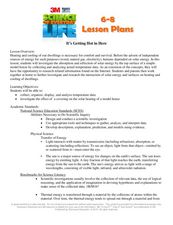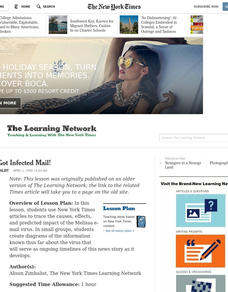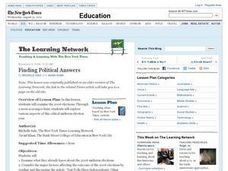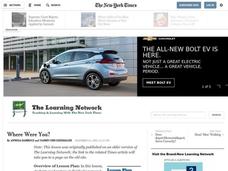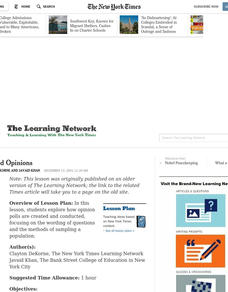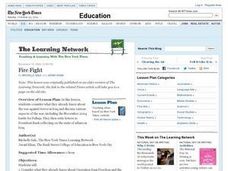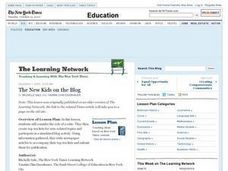Curated OER
It's Getting Hot in Here
Discover the environmental and economic impact of global warming. After reading an article, emerging environmentalists identify how different countries are responding to the Kyoto Protocol. They research emission laws and write a news...
Facing History and Ourselves
The Power of Images
One picture but a thousand stories. As a part of a case study of how the death of Michael Brown was reported by professional news sources and on social media class members examine the reactions of various groups to a photograph taken by...
Curated OER
Not Getting the News about the Stamp Act
How did American colonists react to the Stamp Act of 1765? Your young historians will examine primary source material by reading excerpts from a transcription of the Pennsylvania Gazette and then identifying the sentiments expressed...
Curated OER
Scooting Away from Justice?
Students examine President Bush's July 2007, decision to commute the 30-month sentence of former White House official, I. Lewis 'Scooter' Libby by reading a New York Times article. They scan editorial sources on various sides of the...
Curated OER
Make It or Break It
Learners study about "breaking news" by analyzing the New York Times' coverage of the July 2006 bombing of seven commuter trains in Mumbai, India. They write their own breaking news stories for homework.
Curated OER
What's Your Angle?
Students examine The New York Times' coverage of immigrants' rights in order to gain an understanding of how different news angles function. They assess the angles of different news media outlets, such as television, radio, and Internet...
Curated OER
The Long and Short of It
Students take a look back at the week's news by exploring the news summaries article offered in The New York Times' Week in Review section each week. They look further into ongoing news stories of interest to them in order to create...
Curated OER
Stranger Than Fiction
Students reflect on the importance of science literacy. They review the year's science curriculum by reading, discussing and writing questions on teacher-selected New York Times articles and the related science content.
Curated OER
You've Got Infected Mail!
Students use New York Times articles to trace the causes, effects, and predicted impact of the Melissa e-mail virus. In small groups, students create diagrams of the information about the virus that serves as ongoing timelines of this...
Curated OER
Separate But Equal Opinions
Students examine the ways in which editorials and Op-Ed pieces respond to current events. They write editorials in response to news items from the New York Times.
Curated OER
Finding Political Answers
Students discuss the 2006 midterm elections. They read an article about exit polls. They create a scavenger hunt using articles of the New York Times. They write a paper about the importance of midterm elections.
Curated OER
Justice For All?
Students study about President Bush's nomination of federal appeals court judge John G. Roberts to the Supreme Court. They compare coverage of the nomination in different sections and articles in The New York Times.
Curated OER
Current Contexts
Students examine how they are affected by world affairs. After reading an article, they examine Otto Frank's attempts to immigrate to America. Using the New York Times, they identify examples of news, advertisements and photographs...
Curated OER
Where Were You?
Learners examine various New York Times readers' reflections on the life and death of President John F. Kennedy, by reading and discussing "Readers Reflect on President John F. Kennedy." Students then write their own personal...
Curated OER
Who Gives a Hoot?
Students look at owl migration and its impact on the environment and the food chain after reading an article from The New York Times. Students then apply this information to and research different food chain situations for other species...
Curated OER
The Height of Diplomacy
Students explore issues that might be discussed at the G8 summit meeting hosted by the U.S. after reading and discussing the article "World Leaders Get a Glimpse of America's High Life" from The New York Times. Students work in groups...
Curated OER
On the Fence
Young scholars read a news article from the New York Times related to the construction of a fence between Mexico and the U.S. and its impact on the lives of the people living on both sides. They read and discuss a variety of scenarios,...
Curated OER
Measured Opinions
Students read "Public Is Wary but Supportive on Rights Curbs," at the New York Times online. They explore how opinion polls are created and conducted, focusing on the wording of questions and the methods of sampling a population.
Curated OER
Mixing Metaphors with Politics
Learners discuss different literary devices and use them to write summaries of New York Times articles dealing with international news. They reflect on the effectiveness and appropriateness of sports metaphors in the political arena.
Curated OER
Fire Fight
While somewhat dated (students write letters to President George W. Bush about the Iraq War), this lesson plan could be a good way to reinforce rhetorical reading and critical thinking. Students examine information regarding Operation...
The New York Times
Understanding the Mathematics of the Fiscal Cliff
What exactly is the fiscal cliff? What are the effects of changing income tax rates and payroll tax rates? Your learners will begin by reading news articles and examining graphs illustrating the "Bush tax cuts" of 2001 and 2003. They...
Curated OER
The New Kids on the Blog
Students consider the role of a critic by creating top ten lists for arts-related topics and participate in a simulated blog activity. They write newpaper articles to accompany their top ten lists and submit them for publication.
Curated OER
Not Just the Facts
Encourage your learners to explore the differences between hard news and news analysis. They outline a complex news analysis about the upcoming presidential election, then endeavor to write an analysis of the same topic, using local...
Curated OER
That's News to Me!
Students read about the Newseum and create their own museum exploring various aspects of news media.


